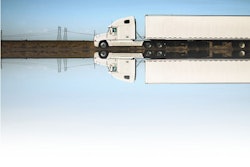Make yourself scarce
Future success calls for more than dependable transportation
It has long been conventional wisdom that you shouldn’t allow any single customer or small number of customers to represent too much of your business. Exactly how much is too much seems to vary from one trucking executive to another, but the goal is limiting the risk to your receivables and future business should a major customer go bankrupt or replace you.
In a traditional irregular route truckload environment – one in which you can be replaced by pretty much anyone else who happens to have capacity – this probably remains sound advice. And regardless of your business model, you need to be concerned about the financial health of your customers.
Viewed through the lens of the supply-and-demand economics that have governed transportation since deregulation, the future looks bright for trucking companies. Over the long run, it’s hard to imagine capacity outstripping freight demand, primarily because finding drivers will become even more difficult.
There are problems with this way of thinking, however. For starters, there will be times when demand just plain stinks, and relatively tight capacity won’t save you unless you have built a sizeable cash cushion. On the other hand, higher freight rates don’t help much if lack of drivers forces you to downsize or lose utilization. And even if you can leverage tight capacity for higher rates, you might not be getting as much return on your investment as you could.
Is your company sticky with your customers?
For Reggie Dupré, the end of a “climate of abundance” in trucking signals a fundamental shift in how successful carriers will do business. Dupré, chief executive officer of Lafayette, La.-based Dupré Logistics, participated in a panel discussion on the future of the trucking industry last month at the American Trucking Associations annual meeting in Grapevine, Texas.
Traditionally, carriers and their customers have had access to enough money, drivers and technicians that the relationship between carriers and shippers naturally was adversarial, Dupré said. Carriers pushed for higher rates, while shippers kept rates low by shopping around. This dynamic is disappearing and will be marked by one driven by the scarcity of resources, Dupré argued. Drivers, who now more than ever need to be “regulation-compliant,” are harder to find. And not only is money harder to get, equipment is becoming more expensive. And even managerial talent is hard to find. The new competitive model will be one of dedicated service and collaboration, Dupré argues.

Avery Vise is executive director, trucking research and analysis for Randall-Reilly and senior editor, industry analysis for Commercial Carrier Journal. E-mail [email protected]
Managing their problems
One of the most obvious ways a carrier can embed itself into a customer is to quite literally take over the transportation function by becoming an asset-based third-party logistics provider. This can be high-margin business for the parent company and a steady source of freight for the carrier, provided the company is prepared to justify its selection of its own capacity where used.
Creating win-win scenarios
Several years ago, Springfield, Mo.-based O&S Trucking worked with Kraft Foods on a program that maximized the load capacity of the refrigerated carrier’s trailers, thereby eliminating one in every 10 loads. With the collaboration of its customers, O&S Trucking created a captive network for its MegaTruck program to ensure that the trucks were fully utilized.
Going the extra mile
Trucking companies might think of their service as delivering goods between docks, but companies have become more valuable by handling goods at the front end through warehousing and even final assembly. And at the other end, could you go the extra mile or even a few more feet? Consider JB Hunt Final Mile, part of the carrier’s dedicated offering. JB Hunt drivers don’t just deliver home appliances or commercial furniture; they install these items, too.













